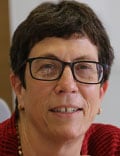When an elderly woman with advanced Alzheimer’s disease entered Laura Mosqueda’s examination room for the first time, the patient sat slumped in her wheelchair.
Mosqueda, a professor of family medicine and geriatrics at the Keck School of Medicine of the University of Southern California in Los Angeles, asked the woman’s son, who was also her caregiver, to leave the room. She told him that she always spends private time with each of her patients. When he was reluctant to leave his mother alone, Mosqueda knew it was vital that he did.

Dr Laura Mosqueda
“When he left the room, his mother unfurled, sat up, and made eye contact with me,” Mosqueda said.
The patient was nonverbal, so Mosqueda read her body language: She believed the woman’s demeanor in the presence of her son was a fear response. When she got the woman undressed and undertook a careful examination, she noted that bruises covered her body.
“She didn’t have any on her face, so I wouldn’t have noticed if I hadn’t gotten her undressed,” said Mosqueda, director of the National Center on Elder Abuse, part of the US Department of Health and Human Services. “The reason I did that was because of this son who didn’t want to leave, which was suspicious, and then her body language changing, which was also suspicious.”
According to a 2019 report by the US Department of Justice (DOJ), 1 in 10 Americans older than 65 experience elder abuse. In most states, it is mandatory that medical providers report such abuse, but there are no nationwide standards for screening, leaving time-strapped physicians to piece together potential clues.

Dr Elizabeth Goldberg
“We are likely missing the vast majority of cases,” said Elizabeth Goldberg, MD, an associate professor of emergency medicine at the University of Colorado School of Medicine in Aurora, whose research is focused on geriatric emergency medicine.
Screening today relies on the discretion of a physician or a series of questionnaires that are not uniform and are not effective for every patient, especially patients who are cognitively or verbally impaired. But some researchers are developing new tools that could be incorprated into existing workflows and that would allow physicians to quickly screen for abuse without interference from possible abusers.
Screening for Neglect
Elder mistreatment can take many forms, including emotional, verbal, physical, or sexual abuse. A caregiver in charge of finances pockets an older adult’s money. Another fails to keep up with an elderly person’s basic needs, such as hygiene and nutrition, or neglects to ensure they’re taking their medications. Abuse can be carried out by employees of care facilities or by family members.
There is no national central tracking system for elder neglect and abuse, and each state has different laws and definitions. As a consequence, comparing differences in rates among states is difficult, according to Mosqueda.
The 2019 DOJ report cited evidence that the risk for abuse and neglect is higher for elderly people living in rural areas and is even higher for those living with dementia or Alzheimer’s disease.
Medical providers are in a unique position to detect and report elder mistreatment, and even to detect early warning signs before abuse occurs.

Dr Tony Rosen
“Going to see a healthcare provider may be the only time an older adult interacts with people outside their home,” said Tony Rosen, MD, an emergency medicine physician at Weill Cornell Medicine and New York–Presbyterian, in New York City.
Rosen is part of a group of researchers at Weill Cornell who recently received a grant from the National Institute on Aging to develop and test a primary care screening tool that identifies elder neglect among patients with Alzheimer’s disease and other forms of dementia.
The National Center on Elder Abuse estimates that nearly half of adults with dementia have experienced abuse. But, “because recruiting older adults with dementia for clinical research is difficult, very little research exists in this population,” Rosen said.
The center provides a series of questionnaires practitioners can use to screen for elder neglect, but Mosqueda said there is not yet evidence as to which questions are most effective at catching abuse.
Last year, researchers at Yale University released VOICES, a web-based app that older patients use on iPads while in the waiting room. Video modules provide education on abuse and neglect and prompt patients to seek help if they need it. But this type of tool might not be right for every patient, especially for those with Alzheimer’s disease or dementia, who may not be able to answer questions, and those whose abusers may be sitting with them in the waiting room.
The team at Weill Cornell is testing the effectiveness of potential questions and is exploring how data in electronic medical records could flag patients who are at risk of being abused. They also hope to develop an intervention that would educate and train caregivers.
Although medical providers are typically not trained to handle problems such as financial abuse, they are uniquely well equipped to pick up signs of physical neglect, according to Rosen.
“If a patient doesn’t receive the care they need, it will impact their health, sometimes within days,” he said.
Mosqueda said screening tools that would fit into a physician’s diagnostic process would be most helpful. Although conditions such as osteoporosis could be to blame for a broken bone, and thinning skin could lead to bruising, physicians must always rule out abuse as a potential cause.
“Abuse has to be on our differential diagnosis because if it isn’t, we will miss it,” she said. “Imagine if we didn’t have heart attack on our differential for chest pain? We’d miss it.”
The Weill Cornell team wants to create a clinical checklist that could be embedded in electronic health records to screen for patterns in a patient’s record that may indicate neglect.
“We want screening to have as few questions as possible and be driven by observations as much as possible. This is particularly relevant for people with dementia who may not be speaking or able to answer questions,” Rosen said.
Once physicians suspect abuse, they can report elder abuse to several entities. Practitioners often must make judgment calls about where and how to report abuse or neglect, especially without tipping off an abusive caregiver before the patient in their care can be safely removed from the situation.
When Mosqueda faced this dilemma, she chose to report the apparent abuse to California’s Adult Protective Services and to follow up with an immediate call to let the agency know the case was urgent. Taking action can prove as lifesaving as prescribed treatments.
“I’m looking at a case right now that will probably be prosecuted as a homicide. She was coming in with wounds and injuries, and no one was thinking elder abuse. She ended up dead,” Mosqueda said. “This has very serious consequences. Screening has to be fast, whatever it is, and there has to be an intervention.”
Kaitlin Sullivan is a health, science, and environmental journalist.
For more news, follow Medscape on Facebook, Twitter, Instagram, and YouTube.
Source: Read Full Article
